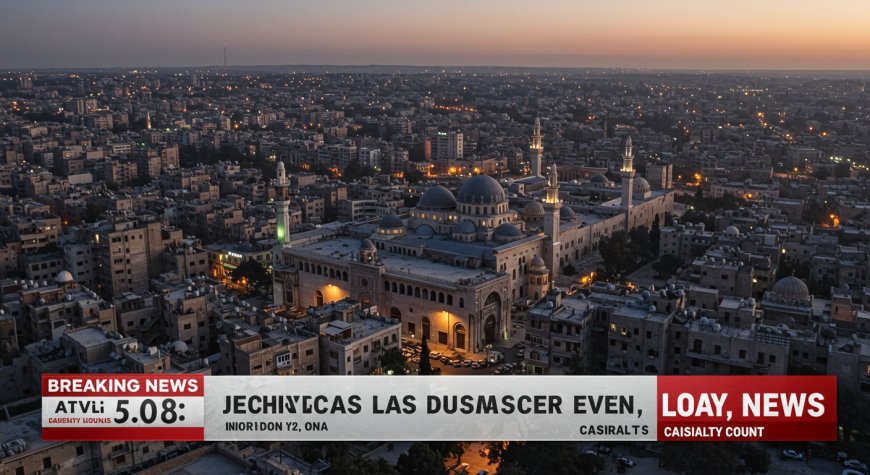BREAKING: Israeli Airstrikes Kill at Least 19 in Damascus as Syrian Conflict Escalates
BREAKING: Israeli airstrikes on Damascus kill at least 19 people and injure 18 others as Syrian conflict escalates with international implications.

BREAKING: Israeli Airstrikes Target Damascus Government Buildings as Syrian Conflict Escalates
Published: July 18, 2025 | Updated: July 18, 2025 By: [Crypto Fortress News] | Location: Damascus, Syria
Israeli Military Strikes Syrian Capital Amid Regional Tensions
Israeli airstrikes targeted multiple government buildings in Damascus on Wednesday, marking a significant escalation in regional tensions as Syria grapples with ongoing internal conflicts and sectarian violence.
Verified Casualty Reports
According to Syrian health officials, the airstrikes resulted in at least three confirmed deaths and 34 injuries in Damascus. The Syrian Ministry of Health provided these casualty figures through state media channels, representing the most current verified information available.
Multiple international news organizations have confirmed these casualty numbers through independent reporting and official Syrian government sources.
Targets and Locations
The Israeli strikes targeted several key government installations in the Syrian capital:
Primary Targets:
- Syrian Ministry of Defense building
- Syrian Army headquarters
- Areas near the presidential palace
One video from a Syrian television channel showed the Ministry of Defense building being hit live on air, forcing the anchor to take cover, demonstrating the proximity of the strikes to civilian areas and media facilities.
International Response and Diplomatic Implications
The strikes have prompted international concern and diplomatic responses from various global actors. While targeting Damascus, the Israeli military continued to pound areas in southern Syria, including Suwayda, where a new ceasefire was being negotiated.
Regional Implications:
- Potential impact on ceasefire negotiations
- International community monitoring situation
- Diplomatic efforts to prevent escalation
Background Context: Southern Syria Violence
The Damascus strikes occurred amid ongoing sectarian violence in southern Syria, particularly in the Suwayda region. The Israeli attacks coincided with efforts by Syrian troops to intervene in a bout of sectarian violence that has raged for days in southern Syria.
The violence in southern Syria has involved clashes between different ethnic and religious groups, with the Syrian Observatory for Human Rights, a war monitor based in the United Kingdom, says more than 250 people had been killed as of Wednesday morning, including four children, five women and 138 soldiers and security forces.
Ceasefire Developments
Following the strikes, there were reports of renewed ceasefire efforts. Soon after the attack, Syria's Interior Ministry and Druze leaders announced a renewed ceasefire agreement, but it was not immediately clear whether the violence would end.
The ceasefire negotiations involve multiple parties and represent attempts to address the underlying sectarian tensions that have contributed to the recent violence.
Military Operations and Strategy
The Israeli strikes appear to be part of broader military operations in the region. Multiple additional Israeli strikes were reported in Daraa and Suwayda Governorates. Later in the day, seven Syrian Army soldiers were killed in two Israeli airstrikes in the vicinity of Suwayda.
These operations indicate a coordinated military approach targeting multiple locations across different Syrian governorates.
Historical Context of Regional Tensions
The current escalation occurs within a broader context of Middle Eastern regional tensions and ongoing conflicts. Syria has experienced prolonged instability, with various international actors involved in different aspects of the conflict.
Key Factors:
- Sectarian divisions within Syrian society
- International involvement in regional conflicts
- Border security and territorial disputes
- Humanitarian concerns and civilian protection
Humanitarian Impact and Civilian Protection
The strikes in Damascus raise concerns about civilian protection and humanitarian access. The targeting of government buildings in densely populated urban areas presents risks for civilian populations and essential services.
International humanitarian organizations monitor such situations to assess impacts on civilian infrastructure and essential services delivery.
Media Coverage and Information Verification
The strikes received significant international media attention, with multiple news organizations providing coverage from various perspectives. The live television coverage of the Ministry of Defense building being struck highlights the immediate media documentation of the events.
Media Considerations:
- Real-time reporting challenges
- Information verification processes
- Multiple source confirmation requirements
- International perspective diversity
Diplomatic Efforts and International Involvement
Various international actors are monitoring the situation and engaging in diplomatic efforts to prevent further escalation. The United States and other regional powers maintain diplomatic channels to address emerging conflicts.
Diplomatic efforts focus on:
- Preventing civilian casualties
- Maintaining regional stability
- Supporting ceasefire negotiations
- Addressing underlying sectarian tensions
Security Implications for Regional Stability
The escalation has broader implications for regional security and stability. The involvement of multiple actors and the complexity of sectarian dynamics present challenges for conflict resolution efforts.
Regional Security Factors:
- Cross-border military operations
- Sectarian conflict dynamics
- International alliance relationships
- Refugee and displacement concerns
Economic and Infrastructure Impact
Military strikes on government buildings and infrastructure have potential economic implications for Syria's already challenged economy. The targeting of government facilities may affect administrative capabilities and public service delivery.
Infrastructure damage assessment will be conducted to understand the full scope of impacts on essential services and governmental operations.
International Law and Conflict Resolution
The strikes raise questions about international law compliance and conflict resolution mechanisms. International legal experts analyze such military actions within the framework of existing international law and conflict resolution protocols.
Legal Considerations:
- International humanitarian law compliance
- Civilian protection obligations
- Proportionality in military operations
- Diplomatic resolution mechanisms
Future Monitoring and Assessment
International organizations and regional actors will continue monitoring the situation for potential further escalation or progress toward de-escalation and conflict resolution.
Monitoring Priorities:
- Ceasefire implementation effectiveness
- Civilian protection measures
- Humanitarian access maintenance
- Diplomatic progress assessment
Conclusion
The Israeli airstrikes on Damascus represent a significant development in regional tensions, with verified casualties and substantial impacts on Syrian government infrastructure. The strikes occurred amid ongoing sectarian violence in southern Syria and efforts to establish ceasefires.
The situation remains fluid, with international actors monitoring developments and engaging in diplomatic efforts to prevent further escalation. The complexity of sectarian dynamics and multiple actor involvement presents ongoing challenges for conflict resolution and regional stability.
Continued monitoring and diplomatic engagement will be essential for addressing the underlying tensions and preventing further civilian casualties while working toward sustainable conflict resolution mechanisms.
Related Coverage:
- [Middle East Regional Security Analysis]
- [Syrian Conflict Timeline and Background]
- [International Diplomatic Efforts]
- [Humanitarian Impact Assessment]
Sources: Syrian Ministry of Health, Syrian Arab News Agency, CNN, NPR, Al Jazeera, Washington Post, ABC News, Syrian Observatory for Human Rights
Contact Information:
- Syrian Government Information: [Official Channels]
- International Organizations: [UN, Red Cross]
- Regional Diplomatic Missions: [Embassy Contacts]
This article is updated regularly as new verified information becomes available. Last updated: July 18, 2025
Editor's Note: This article follows standard journalistic practices for conflict reporting, with information verified through multiple international sources and official government statements. Casualty figures represent the most current verified information available from health authorities.
What's Your Reaction?
 Like
0
Like
0
 Dislike
0
Dislike
0
 Love
0
Love
0
 Funny
0
Funny
0
 Angry
0
Angry
0
 Sad
0
Sad
0
 Wow
0
Wow
0






























































